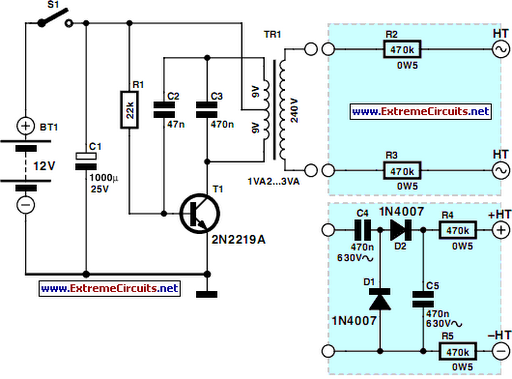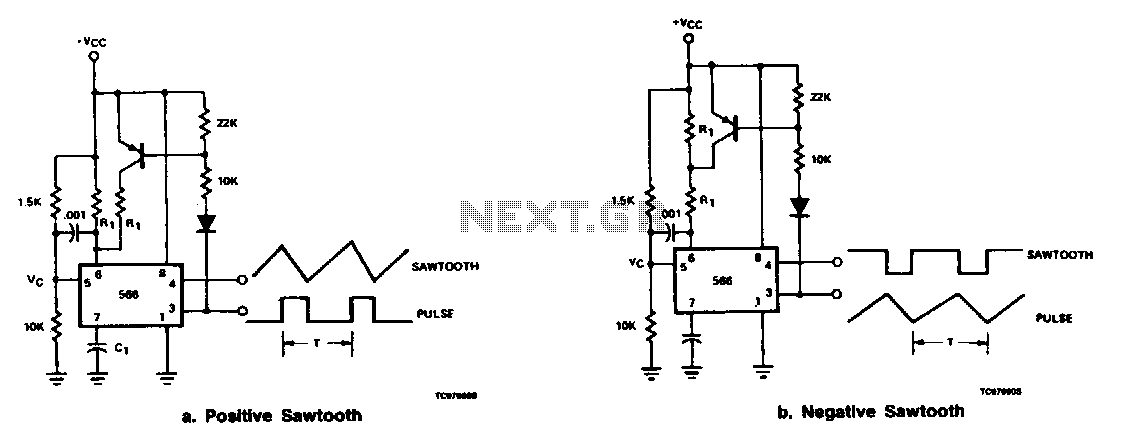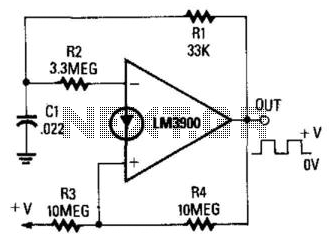
Mini High-Voltage Generator

This project presents a useful device for the beach, intended to deter individuals from touching personal belongings left on a towel while swimming. It can also be employed in an office or workshop setting. The circuit, compact in size and powered by simple primary cells or rechargeable batteries, generates a low-energy, high voltage in the range of approximately 200 to 400 V, which is harmless to humans but can deliver a noticeable shock to anyone who makes contact with it. Additionally, this project serves as an educational tool for younger hobbyists, introducing them to a circuit familiar to those experienced in radio technology, particularly with vacuum tubes. The circuit diagram illustrates a straightforward design, incorporating only a single active component, a standard transistor. The transistor functions as a low-frequency oscillator, converting the battery's DC voltage into an AC voltage that can be amplified using a transformer. The use of a center-tapped transformer enables the construction of a Hartley oscillator around transistor T1, a design prevalent in the era of vacuum tubes before the advent of silicon-based electronics. The Hartley oscillator, named after its inventor Ralph V. L Hartley, is one of several L-C oscillator designs that achieved lasting recognition. For optimal operation and sinewave output, the placement of the intermediate tap on the transformer winding must be carefully selected to achieve the desired voltage reduction ratio. Although the standard transformer used in this project limits the ability to achieve optimum inductive tapping, its central winding position creates sufficient feedback to ensure reliable oscillator startup. However, this excessive feedback results in a non-sinewave output, which is acceptable for this application as the transformer can accommodate it. The output voltage can be accessed directly through two current-limiting resistors, R2 and R3, which are essential for circuit safety and should not be omitted or altered. This configuration yields approximately 200 V peak-to-peak, which is already quite unpleasant to touch. Alternatively, a voltage doubler circuit, illustrated in the diagram, can be utilized to produce around 300 V, increasing the unpleasantness of contact. Resistors R4 and R5 must also be included in this configuration for safety. The circuit consumes only a few tens of milliamperes, regardless of its deterrent function. For prolonged use, it is advisable to power the circuit with ten AAA Ni-MH batteries in a suitable holder to avoid frequent replacement of dry batteries.
The circuit operates on the principle of a Hartley oscillator, which consists of an inductor and a capacitor forming a resonant tank circuit. The transistor serves to amplify the oscillations generated by the tank circuit. When the circuit is powered, the transistor begins to switch on and off, creating alternating current (AC) at a specific frequency determined by the values of the inductors and capacitors in the circuit. The center-tapped transformer plays a crucial role in stepping up the voltage for practical use while ensuring that the circuit remains compact.
The output stage of the circuit is critical for ensuring safety and functionality. The inclusion of current-limiting resistors R2 and R3 prevents excessive current from flowing through the load, reducing the risk of electric shock. The design must adhere to safety standards, as the high voltage output, while non-lethal, can still cause discomfort. The voltage doubler circuit, which consists of additional capacitors and diodes, effectively increases the output voltage by charging the capacitors to twice the input peak voltage, thereby enhancing the deterrent effect without compromising safety.
Overall, this project not only serves a practical purpose but also provides an educational experience for those interested in electronics, showcasing fundamental concepts in oscillator design, voltage transformation, and circuit safety.Here`s a project that could be useful this summer on the beach, to stop anyone touching your things left on your beach towel while you`ve gone swimming; you might equally well use it at the office or workshop when you go back to work. In a very small space, and powered by simple primary cells or rechargeable batteries, the proposed circuit generat
es a low-energy, high voltage of the order of around 200 to 400 V, harmless to humans, of course, but still able to give a quite nasty poke` to anyone who touches it. Quite apart from this practical aspect, this project will also prove instructional for younger hobbyists, enabling them to discover a circuit that all the oldies` who`ve worked in radio, and having enjoyed valve technology in particular, are bound to be familiar with.
As the circuit diagram shows, the project is extremely simple, as it contains only a single active element, and then it`s only a fairly ordinary transistor. As shown here, it operates as a low-frequency oscillator, making it possible to convert the battery`s DC voltage into an AC voltage that can be stepped up via the transformer.
Using a centre-tapped transformer as here makes it possible to build a Hartley` oscillator around transistor T1, which as we have indicated above was used a great deal in radio in that distant era when valves reigned supreme and these was no sign of silicon taking over and turning most electronics into solid state`. The Hartley` is one of a number of L-C oscillator designs that made it to eternal fame and was named after its invertor, Ralph V.
L Hartley (1888-1970). For such an oscillator to work and produce a proper sinewave output, the position of the intermediate tap on the winding used had to be carefully chosen to ensure the proper step-down (voltage reduction) ratio. Here the step-down is obtained inductively. Here, optimum inductive tapping is not possible since we are using a standard, off-the-shelf transformer.
However we`re in luck ” as its position in the centre of the winding creates too much feedback, it ensures that the oscillator will always start reliably. However, the excess feedback means that it doesn`t generate sinewaves; indeed, far from it. But that`s not important for this sort of application, and the transformer copes very well with it. The output voltage may be used directly, via the two current-limiting resistors R2 an R3, which must not under any circum-stances be omitted or modified, as they are what make the circuit safe.
You will then get around 200 V peak-to-peak, which is already quite unpleasant to touch. But you can also use a voltage doubler, shown at the bottom right of the figure, which will then produce around 300 V, even more unpleasant to touch. Here too of course, the resistors, now know as R4 and R5, must always be present. The circuit only consumes around a few tens of mA, regardless of whether it is warding off` someone or not!
If you have to use it for long periods, we would however recommend powering it from AAA size Ni-MH batteries in groups of ten in a suitable holder, in order not to ruin you buying dry batteries. 🔗 External reference
The circuit operates on the principle of a Hartley oscillator, which consists of an inductor and a capacitor forming a resonant tank circuit. The transistor serves to amplify the oscillations generated by the tank circuit. When the circuit is powered, the transistor begins to switch on and off, creating alternating current (AC) at a specific frequency determined by the values of the inductors and capacitors in the circuit. The center-tapped transformer plays a crucial role in stepping up the voltage for practical use while ensuring that the circuit remains compact.
The output stage of the circuit is critical for ensuring safety and functionality. The inclusion of current-limiting resistors R2 and R3 prevents excessive current from flowing through the load, reducing the risk of electric shock. The design must adhere to safety standards, as the high voltage output, while non-lethal, can still cause discomfort. The voltage doubler circuit, which consists of additional capacitors and diodes, effectively increases the output voltage by charging the capacitors to twice the input peak voltage, thereby enhancing the deterrent effect without compromising safety.
Overall, this project not only serves a practical purpose but also provides an educational experience for those interested in electronics, showcasing fundamental concepts in oscillator design, voltage transformation, and circuit safety.Here`s a project that could be useful this summer on the beach, to stop anyone touching your things left on your beach towel while you`ve gone swimming; you might equally well use it at the office or workshop when you go back to work. In a very small space, and powered by simple primary cells or rechargeable batteries, the proposed circuit generat
es a low-energy, high voltage of the order of around 200 to 400 V, harmless to humans, of course, but still able to give a quite nasty poke` to anyone who touches it. Quite apart from this practical aspect, this project will also prove instructional for younger hobbyists, enabling them to discover a circuit that all the oldies` who`ve worked in radio, and having enjoyed valve technology in particular, are bound to be familiar with.
As the circuit diagram shows, the project is extremely simple, as it contains only a single active element, and then it`s only a fairly ordinary transistor. As shown here, it operates as a low-frequency oscillator, making it possible to convert the battery`s DC voltage into an AC voltage that can be stepped up via the transformer.
Using a centre-tapped transformer as here makes it possible to build a Hartley` oscillator around transistor T1, which as we have indicated above was used a great deal in radio in that distant era when valves reigned supreme and these was no sign of silicon taking over and turning most electronics into solid state`. The Hartley` is one of a number of L-C oscillator designs that made it to eternal fame and was named after its invertor, Ralph V.
L Hartley (1888-1970). For such an oscillator to work and produce a proper sinewave output, the position of the intermediate tap on the winding used had to be carefully chosen to ensure the proper step-down (voltage reduction) ratio. Here the step-down is obtained inductively. Here, optimum inductive tapping is not possible since we are using a standard, off-the-shelf transformer.
However we`re in luck ” as its position in the centre of the winding creates too much feedback, it ensures that the oscillator will always start reliably. However, the excess feedback means that it doesn`t generate sinewaves; indeed, far from it. But that`s not important for this sort of application, and the transformer copes very well with it. The output voltage may be used directly, via the two current-limiting resistors R2 an R3, which must not under any circum-stances be omitted or modified, as they are what make the circuit safe.
You will then get around 200 V peak-to-peak, which is already quite unpleasant to touch. But you can also use a voltage doubler, shown at the bottom right of the figure, which will then produce around 300 V, even more unpleasant to touch. Here too of course, the resistors, now know as R4 and R5, must always be present. The circuit only consumes around a few tens of mA, regardless of whether it is warding off` someone or not!
If you have to use it for long periods, we would however recommend powering it from AAA size Ni-MH batteries in groups of ten in a suitable holder, in order not to ruin you buying dry batteries. 🔗 External reference





